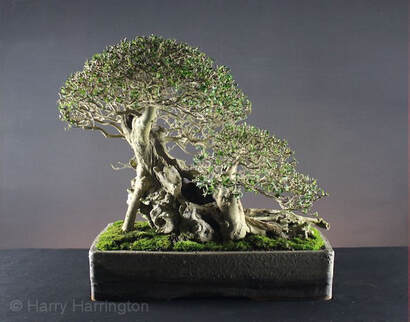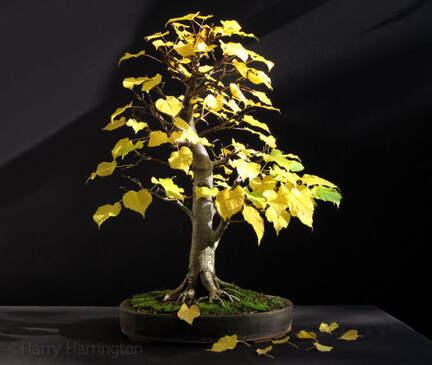Starting Out in Bonsai:

An article by Harry Harrington - from his website www.bonsai4me.com (Thank you Harry).
Although bonsai can be very daunting to newcomers when they first start, in reality it is as simple as you make it. There are many species and varieties of trees available to grow, many new techniques that can be learnt to improve the appearance of a bonsai and a seemingly unfathomable quantity of do's and don'ts. But the most important aspect as a beginner is to learn how to simply maintain the shape of your tree and keep it alive.
Learn to look after your first tree successfully and your confidence will grow enough to broaden your horizons and successfully learn more advanced techniques such as restyling and creating bonsai.
But don't run before you walk. The first fundamental rule to learn when embarking on this art-form is that you are dealing with something living and ever-changing; basic horticulture needs to be followed so that you can successfully maintain your tree.
Ligustrum ovalifolium/Common Privet Bonsai.
Pictured during the Winter. Height 15"/37cm.
Developed by Harry Harrington from an old hedgerow tree collected in 2004.
There are many bonsai techniques and much advice available to the bonsai enthusiast to achieve the ultimate goal of a beautiful tree. Confusingly, information on the many bonsai websites, books and sources worldwide can often be contradictory. It should be understood that for every objective such as repotting, pruning or styling there are a 100 different techniques or viewpoints. Some are based on horticultural fact, some are based on horticultural myth and some are based on horticultural luck! Many of these techniques will work to a certain degree; but unfortunately although not necessarily killing your tree, some advice and/or techniques can result in greatly diminished vigour as your trees cope under stress, whilst some advice, based on simple horticultural fact, can greatly improve the health, appearance and vigour of your tree. It is for you to learn precisely which techniques work for you and your tree in your given situation.
Placement
Nearly all beginners start their journey by buying a bonsai from a garden centre, shopping mall or bonsai nursery, and are often given summary advice.
Unfortunately, unless you buy your tree from a reputable bonsai dealer, you may well have started on the back foot. The most common misconception that beginners have (and many bonsai forum posts can confirm this) is that bonsai can be kept indoors. However, bonsai are still trees and need outdoor living conditions.
Trees need good light, good humidity levels, good air circulation and importantly, many species NEED the cold of winter to go dormant. Inside our homes, trees receive comparatively poor light levels, and the dry air/low humidity levels created by modern day central heating systems can cause many problems. There are species that will tolerate indoor conditions and with the correct placement and care can be grown; indeed, there are also some species that are not hardy enough to tolerate the winter cold. However, these are in the minority. It is far more difficult to cultivate indoor bonsai than outdoor bonsai.
Outdoor species very rarely die immediately when grown inside, they can survive for a number of months. However they slowly lose their health and vigour in the adverse conditions they are forced to cope with, and become susceptible to bugs and disease until they finally start to show outward signs of ill-health; yellowing leaves, lose of foliage and eventually death.
Unfortunately, unscrupulous dealers take advantage of this delayed response and will display and sell outdoor trees as indoor bonsai. A tree purchased from such a retailer may have been grown inside for weeks or months and can be near death without any outward sign. The most common species used for bonsai that cause problems for beginners are Conifers and in particular Junipers and Pines. There are NO coniferous species that can tolerate indoor cultivation for more than 1 to 2 years. It is worth referring to individual plant/tree Species Guides to establish whether you have a tree that can be grown inside or not.
Watering
This seemingly easy technique is the second most common cause of Bonsai-related problems. Under-watering or allowing the compost to dry out completely will instantly kill, or badly damage, most trees; however 'overwatering' can just as equally cause ill-health and eventual death from root-rot and disease.
Although bonsai can be very daunting to newcomers when they first start, in reality it is as simple as you make it. There are many species and varieties of trees available to grow, many new techniques that can be learnt to improve the appearance of a bonsai and a seemingly unfathomable quantity of do's and don'ts. But the most important aspect as a beginner is to learn how to simply maintain the shape of your tree and keep it alive.
Learn to look after your first tree successfully and your confidence will grow enough to broaden your horizons and successfully learn more advanced techniques such as restyling and creating bonsai.
But don't run before you walk. The first fundamental rule to learn when embarking on this art-form is that you are dealing with something living and ever-changing; basic horticulture needs to be followed so that you can successfully maintain your tree.
Ligustrum ovalifolium/Common Privet Bonsai.
Pictured during the Winter. Height 15"/37cm.
Developed by Harry Harrington from an old hedgerow tree collected in 2004.
There are many bonsai techniques and much advice available to the bonsai enthusiast to achieve the ultimate goal of a beautiful tree. Confusingly, information on the many bonsai websites, books and sources worldwide can often be contradictory. It should be understood that for every objective such as repotting, pruning or styling there are a 100 different techniques or viewpoints. Some are based on horticultural fact, some are based on horticultural myth and some are based on horticultural luck! Many of these techniques will work to a certain degree; but unfortunately although not necessarily killing your tree, some advice and/or techniques can result in greatly diminished vigour as your trees cope under stress, whilst some advice, based on simple horticultural fact, can greatly improve the health, appearance and vigour of your tree. It is for you to learn precisely which techniques work for you and your tree in your given situation.
Placement
Nearly all beginners start their journey by buying a bonsai from a garden centre, shopping mall or bonsai nursery, and are often given summary advice.
Unfortunately, unless you buy your tree from a reputable bonsai dealer, you may well have started on the back foot. The most common misconception that beginners have (and many bonsai forum posts can confirm this) is that bonsai can be kept indoors. However, bonsai are still trees and need outdoor living conditions.
Trees need good light, good humidity levels, good air circulation and importantly, many species NEED the cold of winter to go dormant. Inside our homes, trees receive comparatively poor light levels, and the dry air/low humidity levels created by modern day central heating systems can cause many problems. There are species that will tolerate indoor conditions and with the correct placement and care can be grown; indeed, there are also some species that are not hardy enough to tolerate the winter cold. However, these are in the minority. It is far more difficult to cultivate indoor bonsai than outdoor bonsai.
Outdoor species very rarely die immediately when grown inside, they can survive for a number of months. However they slowly lose their health and vigour in the adverse conditions they are forced to cope with, and become susceptible to bugs and disease until they finally start to show outward signs of ill-health; yellowing leaves, lose of foliage and eventually death.
Unfortunately, unscrupulous dealers take advantage of this delayed response and will display and sell outdoor trees as indoor bonsai. A tree purchased from such a retailer may have been grown inside for weeks or months and can be near death without any outward sign. The most common species used for bonsai that cause problems for beginners are Conifers and in particular Junipers and Pines. There are NO coniferous species that can tolerate indoor cultivation for more than 1 to 2 years. It is worth referring to individual plant/tree Species Guides to establish whether you have a tree that can be grown inside or not.
Watering
This seemingly easy technique is the second most common cause of Bonsai-related problems. Under-watering or allowing the compost to dry out completely will instantly kill, or badly damage, most trees; however 'overwatering' can just as equally cause ill-health and eventual death from root-rot and disease.

'Overwatering' is something of a misnomer; if a bonsai is planted in a good quality/well-drained bonsai soil it is literally impossible to overwater. Root-rot is the result of a tree growing in poor-draining soil that remains wet , and more specifically, is airless, causing the roots to die rather than the act of too-frequent watering.
The most important Watering-rule to remember is that trees should be CHECKED for their water requirement at least once every day but should only be watered as required. When the surface of the soil starts to dry out, then the tree can be thoroughly watered again. The time between watering can vary from 12 hours to 7 days depending on many factors such as prevailing temperatures, tree growth-rates, wind and humidity levels.
Small-Leaved Lime/Tilia cordata bonsai in autumn.
Height 22"/56cm.
Developed from a pencil-thick sapling by Harry Harrington since 2001
